
Borrowing a laptop PC from someone is a bit like driving someone else’s car, or crashing at someone else’s house. For some it’s not the most comfortable experience, because everything is different, and you can’t really move or change anything without that feeling on the back of your head that makes you wonder if you are going to be reprimanded or yelled at.
The “personal” in personal computer is there for a reason. All of our lives are in one tiny hard drive, from resumes, to private emails, bank statements, shopping lists... everything.
Entrusting someone with all of that, is a leap of faith that’s not for everyone, unless you know the borrower really well.
Aside from privacy concerns, lending a laptop, to some, means to compromise and be ok with the expectation that by the time the device is returned, a few things might be out of place, from a different wallpaper, to theme colors, and maybe a few desktop items added or missing.
By that token, we could lay out a wordy tutorial on how to restrict the ability to install 3rd party applications and customization of the desktop, using the Group Policy Editor, but the truth is: who reads that stuff?
Most users won't bother going that far, with that said, there is one simple trick to do away with the discomfort of lending your laptop to someone else, while keeping your operating system just the way it is.
Windows 10 allows to create bootable instances of itself that can run from a USB flash drive, and the process is actually very easy to get through.
Create a Windows 10 bootable USB drive
The first step is to sign into your Windows 10 computer, and create a Windows 10 ISO file. ISO files are large files that contain the entire operating system, in a form that can be burned into a DVD, or used to create a flash drive from which to install, or even use Window 10.
Bootable USB drives have been popularized by Linux distributors, who would create “Live DVDs”, essentially DVDs containing operating systems that can not only install, but also boot natively, using the DVD and RAM as hard drives.
Of course using a DVD means that no data can be saved, unless an additional storage drive is available, however when using a USB drive, the same storage used to host the live operating system can be used to save files and set up your desktop experience for future uses.
Imagine lending a laptop to someone, with the only requirement being that they use it as long as they keep a tiny stick drive plugged in. Easy enough?
To create a bootable image (ISO), Microsoft has devised a Media Creation tool, designed to create a bootable setup medium identical to those sold in stores.
Microsoft Media Creation Tool can be found at the following link, and it’s free to download and use: https://www.microsoft.com/en-us/software-download/windows10
When running Microsoft Media Creation Tool, the app guides you through a number of configuration pages where you can select the version of Windows 10 (32-bit/64-bit, Home, Pro, Enterprise...) and the language.
Next the wizard will let you choose which media to use, which is either a USB flash drive, or an ISO file that can be burned onto a DVD, or setup on a flash drive at a later time.
Choosing the first option will result in a bootable installation of Windows 10, but that’s not what we want, so we will select the second option, and save the new image as an ISO file on the desktop, or anywhere easily accessible.
The second phase requires a third-party application that can turn the newly created ISO file into a live installation of Windows 10 that can run straight from a USB drive.
Windows To Go Creator, from EasyUEFI is a free shareware application with a paid commercial version available to organizations or individuals looking for more options and expanded functionality, but for this purpose, the free version will work just fine.
Creating a running installation of Windows 10 on a USB drive is easy as pie with this tool. When opening Windows To Go Creator, it will take you straight to a screen where to select the type of Windows 10 installation to clone onto a USB drive. Next we’ll select the type of partition to set up on the USB drive, which in this case should be set to MBR for BIOS.
When asked about the installation mode, we’ll choose Legacy and click Next to initiate the creation of the new medium until progress reaches 100%.
Running Windows 10 on a stick
The first time you run Windows 10 from a thumb drive, you need to configure everything as you would on a regular PC. Wi-Fi passwords, user privileges, Cortana, etc. Once all of it is done and you finally see the desktop, there are a few things to keep in mind.
First, the flash drive where Windows 10 “on the go” is running, and the internal system drive on the host machine are mutually exclusive, and will not be able to see each other. This is intentional, to avoid accidental modification or deletion of system files on the local operating system.
At the same time, when running the regular Windows 10, the USB drive with the portable version of Windows 10 is completely invisible and inaccessible by the local system.
Another thing to keep in mind is that if you plan to use the Windows 10 on a stick on multiple computer, each time you boot from a different computer, you will be asked to activate Windows 10 with a valid license, which can be done by simply signing in with a registered and valid Microsoft account.
Ready to shop?
PortableOne has the best deals on Microsoft Surface Book laptops, and more powerful devices for work and downtime.